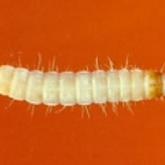Wireworms

True wireworm adult
© D. Ironside Queensland Government

True wireworm larvae
© J. Wessels Queensland Government

Eastern false wireworm adult and larva
© D. Ironside Queensland Government

Small false wireworm adult and larva
© D. Ironside Queensland Government
Wireworms are named for the supposed wire-like appearance of their larvae. There are many species of both true and false wireworms, although most are not pests. Several species of wireworms may occur in any particular crop, depending on locality, soil type, organic matter and tillage practices.
Scientific name
Pterohelaeus spp., Gonocephalum spp. (false wireworm)
Other names
- Agrypnus spp. are also known as click beetles
Agrypnus variabilis - sugarcane wireworm
Pterohelaeus spp. - eastern false wireworm, striate false wireworm
Gonocephalum spp. - small false wireworm, southern false wireworm, northern false wireworm
Description
Wireworm beetles
- Dark grey, brown or black.
- True wireworm adults are 25mm long, elongated and jump/click when disturbed.
- True wireworm eggs are ovoid, 0.6 x 0.5mm.
- False wireworm adults are 10-20mm long and have flanges around the outline of the thorax.
Larvae
- 30-35mm long (Gonocephalum spp. are about half this size).
- Shiny and cream, yellow or tan.
- 3 pairs of legs close to the head.
- True wireworms are soft-bodied, and flatter in cross-section with a flattened head.
- False wireworms are hard-bodied, cylindrical and segmented with a rounded head.
Distribution and habitat
- Minor, widespread, and regular pests.
- False wireworm is mainly a pest in areas with heavy, black soils.
Hosts
True wireworms originally inhabited native grasslands but have adapted to field crops and pastures. They are also predatory, feeding on soil invertebrates.
False wireworms feed in the soil on vegetation, including roots. Crops attacked include cereals, cotton, soybeans and sunflowers.
Damage
- Wireworm larvae feed on germinating seed and chew on seedling roots and shoots, resulting in patchy stands (reduced vigour or seedling death).
- False wireworm adults chew on seedlings at or above ground level, ring-barking or completely cutting the stem.
- Risk period: Immediately after sowing and early seedling growth, especially if germination is delayed by cold, we weather.
Life cycle
Most wireworm complete a single generation in a year. Majority of adults emerge during spring and early summer.
True wireworm
- Adult females live for up to 7 weeks in the field.
- Lay eggs either singly on the soil surface or in batches of 10-15 eggs in crevices to 5 cm deep.
- Develop through 8 larval instars over about 315 days.
- Final (and most damaging) instar stage takes about 150 days.
- Pupate for about 2 weeks in the soil from October-January.
False wireworm
- Eggs are laid singly in moist soil, usually under trash or low-growing weeds.
- Larvae feed on decaying vegetable matter and crop residues in the soil, as well as on newly germinated seed.
- Most larval damage to germinating crops occurs during spring while adults are most troublesome in summer.
Monitoring and thresholds
Use germinating seed baits (GSB) or digging and sieving to detect larvae before planting. Treatment is required if more than 25 wireworm larvae are found in 20 GSB. Monitor crops after sowing until establishment.
In contrast to a number of species of click beetles, Agrypnus variabilis adults do not fly to lights.
Natural enemies
Common brown earwig
Control
- Seed dressings, in-furrow sprays and granular insecticides offer some control over larvae. For adults, use cracked grain baits.
- False wireworm prefers cultivated soils to zero till. Use press wheels at sowing, set at 2-4kg per cm after planting rain or 4-8kg per cm in dry soil.
Further information
- Do I have a wireworm—true or false—The Beatsheet
- True wireworm—Cesar PestNotes
- Eastern false wireworm—Cesar PestNotes
- Southern false wireworm—Cesar PestNotes
- Monitoring for establishment pests prior to sowing—The Beatsheet
- Using germinating grain baits (video)—The Beatsheet
- Registered chemicals database—Australian Pesticides and Veterinary Medicines Authority (APVMA)